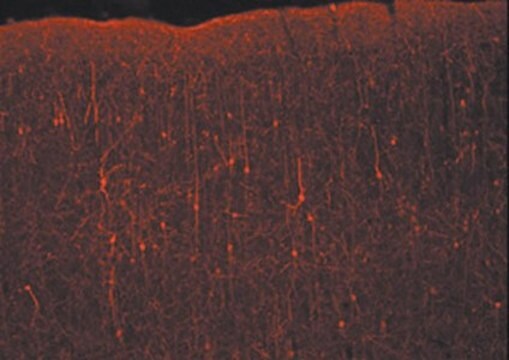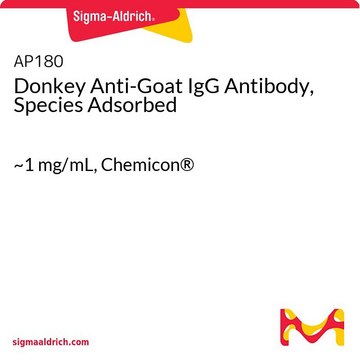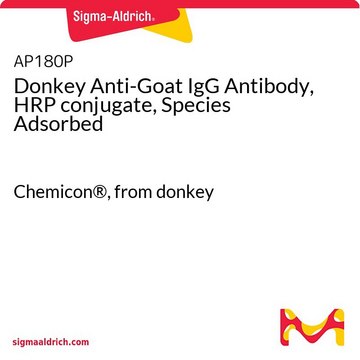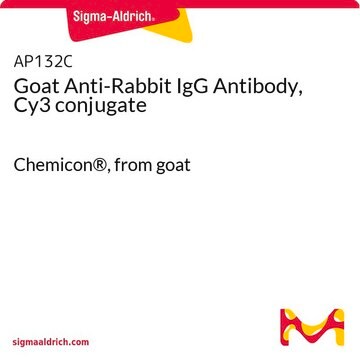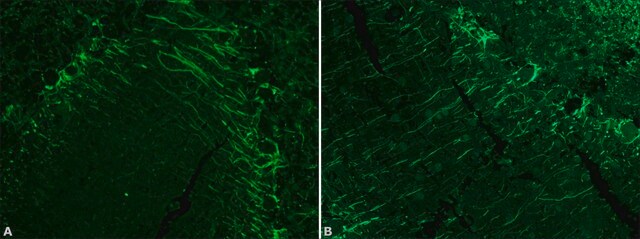AP180C
Donkey Anti-Goat IgG Antibody, Cy3 conjugate, Species Adsorbed
Chemicon®, from donkey
Zaloguj sięWyświetlanie cen organizacyjnych i kontraktowych
About This Item
Kod UNSPSC:
12352203
eCl@ss:
32160702
NACRES:
NA.46
Polecane produkty
pochodzenie biologiczne
donkey
Poziom jakości
białko sprzężone
CY3 conjugate
forma przeciwciała
F(ab′)2 fragment of affinity isolated antibody
rodzaj przeciwciała
secondary antibodies
klon
polyclonal
reaktywność gatunkowa
goat
producent / nazwa handlowa
Chemicon®
metody
immunofluorescence: suitable
Warunki transportu
wet ice
docelowa modyfikacja potranslacyjna
unmodified
Powiązane kategorie
Opis ogólny
Immunoglobulin G (IgG), is one of the most abundant proteins in human serum with normal levels between 8-17 mg/mL in adult blood. IgG is important for our defence against microorganisms and the molecules are produced by B lymphocytes as a part of our adaptive immune response. The IgG molecule has two separate functions; to bind to the pathogen that elicited the response and to recruit other cells and molecules to destroy the antigen. The variability of the IgG pool is generated by somatic recombination and the number of specificities in an individual at a given time point is estimated to be 1011 variants.
Specyficzność
Goat IgG
Zastosowanie
Research Category
Secondary & Control Antibodies
Secondary & Control Antibodies
Research Sub Category
Secondary Antibodies Adsorbed for Dual Labeling
Secondary Antibodies Adsorbed for Dual Labeling
This Donkey anti-Goat IgG Antibody, Cy3 conjugate, Species Adsorbed is validated for use in IF for the detection of Donkey Goat IgG.
Informacje prawne
CHEMICON is a registered trademark of Merck KGaA, Darmstadt, Germany
Oświadczenie o zrzeczeniu się odpowiedzialności
Unless otherwise stated in our catalog or other company documentation accompanying the product(s), our products are intended for research use only and are not to be used for any other purpose, which includes but is not limited to, unauthorized commercial uses, in vitro diagnostic uses, ex vivo or in vivo therapeutic uses or any type of consumption or application to humans or animals.
Ta strona może zawierać tekst przetłumaczony maszynowo.
Nie możesz znaleźć właściwego produktu?
Wypróbuj nasz Narzędzie selektora produktów.
Zwroty wskazujące rodzaj zagrożenia
Zwroty wskazujące środki ostrożności
Klasyfikacja zagrożeń
Aquatic Chronic 3
Kod klasy składowania
11 - Combustible Solids
Klasa zagrożenia wodnego (WGK)
WGK 3
Certyfikaty analizy (CoA)
Poszukaj Certyfikaty analizy (CoA), wpisując numer partii/serii produktów. Numery serii i partii można znaleźć na etykiecie produktu po słowach „seria” lub „partia”.
Masz już ten produkt?
Dokumenty związane z niedawno zakupionymi produktami zostały zamieszczone w Bibliotece dokumentów.
Quantification of lipid droplets and associated proteins in cellular models of obesity via high-content/high-throughput microscopy and automated image analysis.
McDonough, PM; Agustin, RM; Ingermanson, RS; Loy, PA; Buehrer, BM; Nicoll, JB; Prigozhina et al.
Assay and Drug Development Technologies null
Angiotensin II type 1 receptors may not influence response of spinal autonomic neurons to axonal damage.
Hui Tang,Jaroslav Pavel,Juan M Saavedra,Stephen Brimijoin
Neurological Research null
Phosphorylated Smad2/3 immunoreactivity in sporadic and familial amyotrophic lateral sclerosis and its mouse model.
Masataka Nakamura,Hidefumi Ito,Reika Wate,Satoshi Nakano,Asao Hirano,Hirofumi Kusaka
Acta neuropathologica null
Holger Dannenberg et al.
The Journal of neuroscience : the official journal of the Society for Neuroscience, 39(18), 3434-3453 (2019-02-26)
The firing rate of speed cells, a dedicated subpopulation of neurons in the medial entorhinal cortex (MEC), is correlated with running speed. This correlation has been interpreted as a speed code used in various computational models for path integration. These
Expression profile of PTPIP51 in mouse brain.
P Koch,M Viard,A Stenzinger,A Brobeil,C Tag,K Steger,M Wimmer
The Journal of Comparative Neurology null
Nasz zespół naukowców ma doświadczenie we wszystkich obszarach badań, w tym w naukach przyrodniczych, materiałoznawstwie, syntezie chemicznej, chromatografii, analityce i wielu innych dziedzinach.
Skontaktuj się z zespołem ds. pomocy technicznej